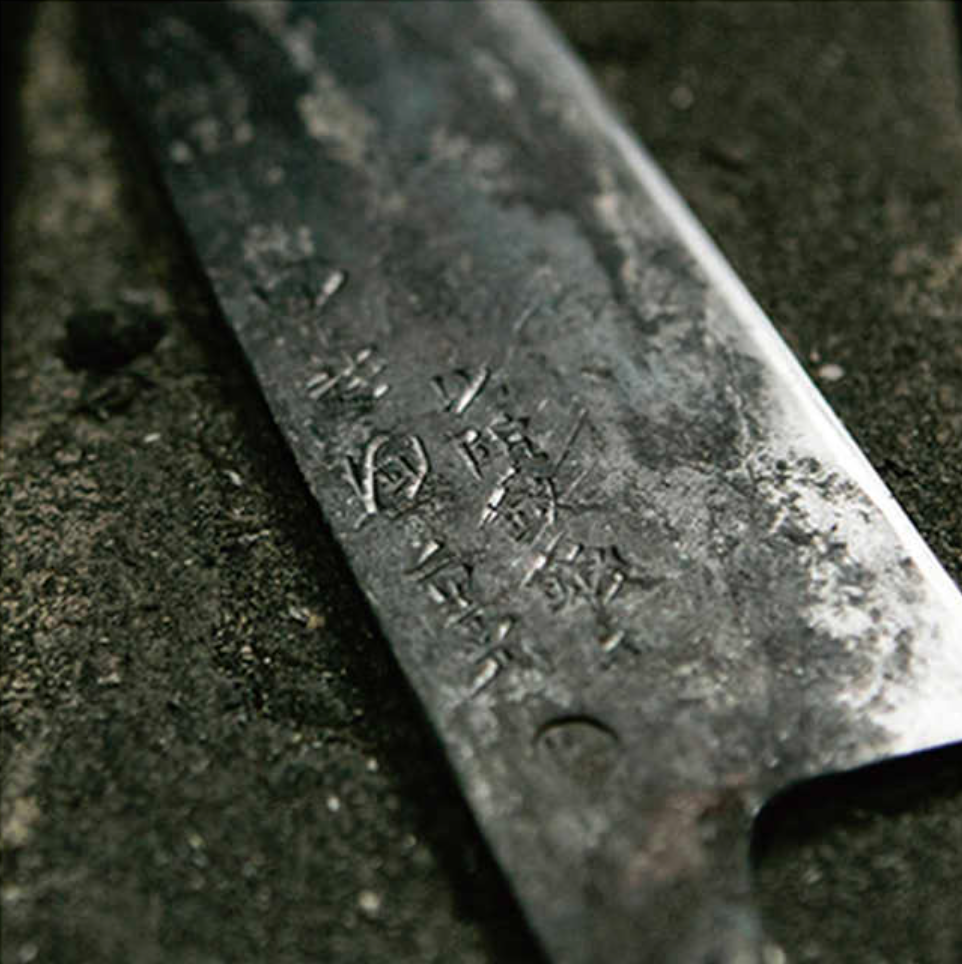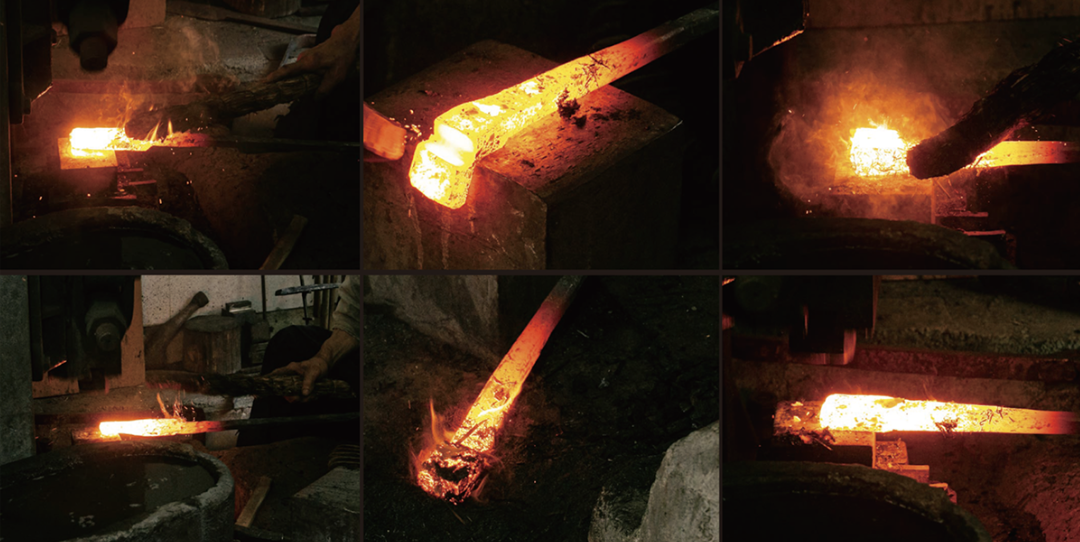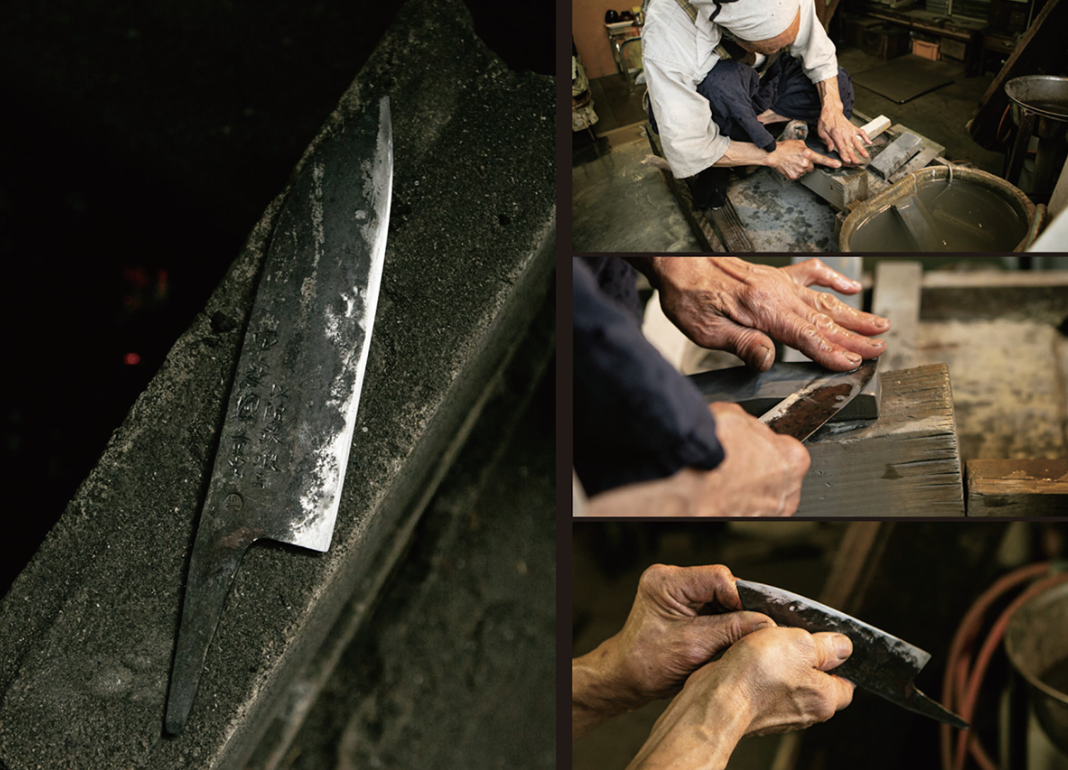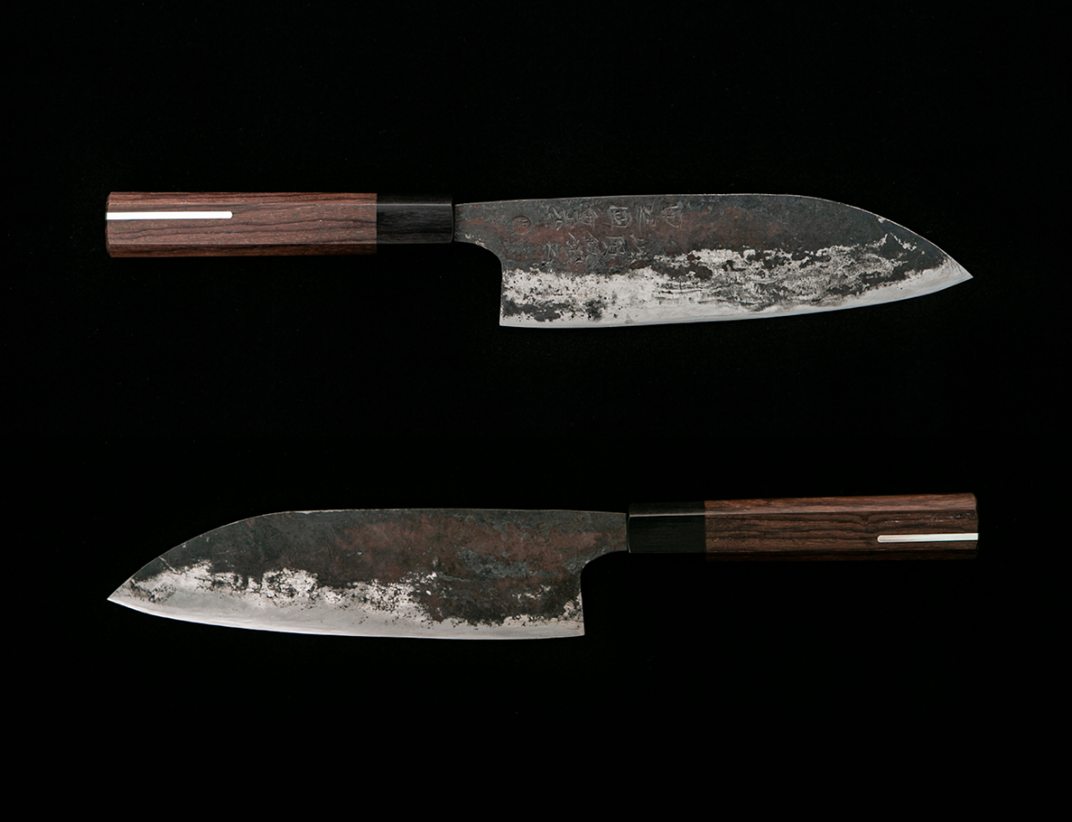Hocho
Technology of Meteoric Iron Blade
Presented to the Emperor of Japan:
Revived in the Modern Age
Meteorites enter the atmosphere at astonishing speeds of 11–72 km per second and fall to the ground without burning up. Many of these meteorites are the “cosmic memory” of primitive planets that collided with one another and scattered about 4.6 billion years ago during the formation of the solar system.
Meteoritic iron is mainly composed of iron and nickel and is thought to have formed during the condensation and recrystallization of iron in the primitive solar system.

Meteorite blades sought by ancient powers
Rulers of past and present, regardless of their knowledge on the history of meteorites, were fascinated by them and found a special power in them.
The meteoric blades of rulers such as the King Tutankhamen of Egypt, the Mughal emperor of India, and the sabers of Tsar Alexander I of Russia have been valued as charming treasures that symbolize the most powerful elites in history. These blades were either ordered to be manufactured or were offered to the aforementioned rulers.
There have been attempts to make Japanese swords from meteoritic iron in Japan; however, because meteoritic iron contains many nonferrous metals such as nickel, it has been considered almost impossible to make such artifacts with 100% meteoritic iron. In fact, the sword presented to the Japanese Emperor Taisho contained only a small percentage of meteoritic iron.
But a modern swordsmith has made the impossible possible. Profile of Swordsmith: Shigemitsu Ito
Profile of Swordsmith: Shigemitsu Ito
Born in 1953. From a young age, he grew up with a strong interest in the sound of a hammer being hit by a blacksmith in his neighborhood, and during his first year of junior high school, he decided he would become a swordsmith.
After graduating from high school, he began training as a swordsmith. In 1979, he became a certified artisan by the Agency for Cultural Affairs, and the following year, he became an independent swordsmith.
Since then, he has been making swords with steel he made, aiming to “reproduce the masterpieces from the Kamakura period (1185–1333), something no other swordsmith has been able to do for the past 400 years.
He has been receiving requests from sword lovers in Japan and from abroad who were attracted to his independent approach and quality of his swords. He has already produced over 500 swords.
In recent years, he has been experimenting with making swords using only meteoric iron, which requires extremely delicate and advanced forging techniques, succeeding in this task with this unique method.
In 2018, he provided a sword to be used in the ring-purification ritual for the 72nd Sumo champion wrestler, Kise-no-Sato.








Difficulty of making swords from meteoric iron
Usually, swordsmiths purchase tamahagane (gem steel), a material with few impurities used for forging Japanese swords. However, he made swords using his own collection of charcoal and iron sand. Interestingly, Ito discovered that silicon compounds played an important role in reproducing ancient Japanese swords.

He then applied his unique knowledge and skills to produce meteoritic iron swords and established a method for temperature control and forging to produce blades that manitain the texture of meteoric iron.
(Japan Patent No. 7050373 / Inventor: Shigemitsu Ito/Applicant: neten Inc.)

We commissioned swordsmith Ito to create Japanese swords, including those that serve as sacred objects, all of which were masterpieces of swordsmanship.
When we asked him to make a 137-centimeter meteoric iron sword as a sacred object, or the symbol of the Japanese deity, which was twice as long as ordinary Japanese swords. He was told by his fellow swordsmiths that it was absolutely impossible and that he should refuse the request. However, Ito accomplished this divine feat through an insatiable pursuit of his craftsmanship and using his deep knowldege of iron.
A knife made of meteoric iron born from the skill of a swordsmith
In this study, with the full cooperation of swordsmith Ito, we produced a meteoric iron knife, sublimating the rare meteoric iron and Ito's rare Japanese sword-making techniques into a work of art of the highest caliber.
The purpose of daily food consumption is to consume nutrients. We also absorb the energy of the ingredients, but also of the chef that prepares the food.
Meteoric iron, which can be said to be from the primitive form of the Earth, also stores information about the primitive solar system. The knife was forged from this extremely precious material and by the extraordinary swordsmith Shigemitsu Ito. The end product was named “Hocho” after the energy of food and dishes filled with genuine energy, which brings harmony to modern people.









Impressions by Culinary Artisan
Japanese swords have been made even after they ceased to play a leading role in the battlefield, and for more than a millennium, some have remained in a condition that allows them to function as tools.
Hou Cho, born from the techniques of making the best Japanese swords, is also a tool and a work of art.
What do professional chefs that have been using kitchen knives for many years feel about this meteoric iron knife?
Yasuhiro Iwami’s Profile
He owns and operates the Japanese-style restaurant ‘Kagetsu’. He started his culinary career at the age of 20, gaining experience as a Japanese chef at ryotei restaurants and hotels. With 40 years of experience, he offers colorful dishes representing all four seasons with a unique creativity. He can play the didgeridoo (an aboriginal instrument indigenous to the Australian continent), and is well versed in ancient Japanese Jomon culture.
Interviewer
Could you tell us about your first impression when you held a knife made of meteoric iron in your hand for the first time?
Iwami
I was very impressed. I had heard that the knife was forged from a very rare meteoric iron rock that reached Earth from outer space, and so the moment I held it in my hand, I knew everything would change.
Interviewer
You have used many kitchen knives in the past. Could you tell us the difference between a knife made of meteoric iron and ordinary knives?
Iwami
This may seem surprising, but I have not considered the quality of kitchen knives to be very important. Of course, I use high-quality knives and take good care of them, but there are many sharp knives that can cut food neatly.
However, when I held the knife, my consciousness changed. My way of thinking about the knife itself, the way I deal with the ingredients, the finished dish, and my thoughts about the people who will be eating the food...it changed everything.
Interviewer
So Hou Cho has changed your cooking.
Iwami
Exactly. As a chef, it is my pleasure to serve the best food using the best ingredients. We take advantage of our location to purchase fresh fish every day, and we grow our own vegetables.
We are particularly interested in water and use water pumped up from 100 m underground underneath Mt. Fuji, which has been absorbed from the ground and filtered through volcanic rocks over thousands of years. Therefore, water is not only pure, but also contains just the right amount of minerals to greatly enhance the ingredients.
Now that I have come across this knife, I can cook with the best ingredients using the best tool. This pleasure surpasses anything a chef could ask for.
Interviewer
I see, so you have everything you need to cook the best food. How do you feel about this?
Iwami
Interestingly, when I cook with this knife, creativity comes naturally, and my cooking changes rapidly. It is as if things that you do not normally think about just come out of you. Creativity is an important element in cooking, but it does not work if you try to do something unusually. Instead, it is about noticing things you have not noticed before.
Everything you need is close to your hands. Instead of trying to do something difficult, a small change in what is at hand can create something totally different and new. People in the Jomon period may have lived in harmony with nature with this fulfilling feeling. I believe that this knife gave me the opportunity to feel more spiritual.
Interviewer
Has a single knife changed a professional cook's sensibilities to such an extent?
Iwami
Yes, it has. I have completely changed my mindset, or rather, my awareness of how to improve myself. I can say this not only about cooking but about everything. Every day, something definitely changes. I enjoyed this experience of using the knife.
Interviewer
Finally, is there anything you would like to tell people who use this knife?
Iwami
This knife is, of course, a wonderful tool, but its value is immeasurable. I hope that you will not only use it yourself but also pass it down from generation to generation as a family heirloom.
Couldn't load pickup availability




Description
Hocho
Technology of Meteoric Iron Blade
Presented to the Emperor of Japan:
Revived in the Modern Age
Meteorites enter the atmosphere at astonishing speeds of 11–72 km per second and fall to the ground without burning up. Many of these meteorites are the “cosmic memory” of primitive planets that collided with one another and scattered about 4.6 billion years ago during the formation of the solar system.
Meteoritic iron is mainly composed of iron and nickel and is thought to have formed during the condensation and recrystallization of iron in the primitive solar system.

Meteorite blades sought by ancient powers
Rulers of past and present, regardless of their knowledge on the history of meteorites, were fascinated by them and found a special power in them.
The meteoric blades of rulers such as the King Tutankhamen of Egypt, the Mughal emperor of India, and the sabers of Tsar Alexander I of Russia have been valued as charming treasures that symbolize the most powerful elites in history. These blades were either ordered to be manufactured or were offered to the aforementioned rulers.
There have been attempts to make Japanese swords from meteoritic iron in Japan; however, because meteoritic iron contains many nonferrous metals such as nickel, it has been considered almost impossible to make such artifacts with 100% meteoritic iron. In fact, the sword presented to the Japanese Emperor Taisho contained only a small percentage of meteoritic iron.
But a modern swordsmith has made the impossible possible. Profile of Swordsmith: Shigemitsu Ito
Profile of Swordsmith: Shigemitsu Ito
Born in 1953. From a young age, he grew up with a strong interest in the sound of a hammer being hit by a blacksmith in his neighborhood, and during his first year of junior high school, he decided he would become a swordsmith.
After graduating from high school, he began training as a swordsmith. In 1979, he became a certified artisan by the Agency for Cultural Affairs, and the following year, he became an independent swordsmith.
Since then, he has been making swords with steel he made, aiming to “reproduce the masterpieces from the Kamakura period (1185–1333), something no other swordsmith has been able to do for the past 400 years.
He has been receiving requests from sword lovers in Japan and from abroad who were attracted to his independent approach and quality of his swords. He has already produced over 500 swords.
In recent years, he has been experimenting with making swords using only meteoric iron, which requires extremely delicate and advanced forging techniques, succeeding in this task with this unique method.
In 2018, he provided a sword to be used in the ring-purification ritual for the 72nd Sumo champion wrestler, Kise-no-Sato.








Difficulty of making swords from meteoric iron
Usually, swordsmiths purchase tamahagane (gem steel), a material with few impurities used for forging Japanese swords. However, he made swords using his own collection of charcoal and iron sand. Interestingly, Ito discovered that silicon compounds played an important role in reproducing ancient Japanese swords.

He then applied his unique knowledge and skills to produce meteoritic iron swords and established a method for temperature control and forging to produce blades that manitain the texture of meteoric iron.
(Japan Patent No. 7050373 / Inventor: Shigemitsu Ito/Applicant: neten Inc.)

We commissioned swordsmith Ito to create Japanese swords, including those that serve as sacred objects, all of which were masterpieces of swordsmanship.
When we asked him to make a 137-centimeter meteoric iron sword as a sacred object, or the symbol of the Japanese deity, which was twice as long as ordinary Japanese swords. He was told by his fellow swordsmiths that it was absolutely impossible and that he should refuse the request. However, Ito accomplished this divine feat through an insatiable pursuit of his craftsmanship and using his deep knowldege of iron.
A knife made of meteoric iron born from the skill of a swordsmith
In this study, with the full cooperation of swordsmith Ito, we produced a meteoric iron knife, sublimating the rare meteoric iron and Ito's rare Japanese sword-making techniques into a work of art of the highest caliber.
The purpose of daily food consumption is to consume nutrients. We also absorb the energy of the ingredients, but also of the chef that prepares the food.
Meteoric iron, which can be said to be from the primitive form of the Earth, also stores information about the primitive solar system. The knife was forged from this extremely precious material and by the extraordinary swordsmith Shigemitsu Ito. The end product was named “Hocho” after the energy of food and dishes filled with genuine energy, which brings harmony to modern people.









Impressions by Culinary Artisan
Japanese swords have been made even after they ceased to play a leading role in the battlefield, and for more than a millennium, some have remained in a condition that allows them to function as tools.
Hou Cho, born from the techniques of making the best Japanese swords, is also a tool and a work of art.
What do professional chefs that have been using kitchen knives for many years feel about this meteoric iron knife?
Yasuhiro Iwami’s Profile
He owns and operates the Japanese-style restaurant ‘Kagetsu’. He started his culinary career at the age of 20, gaining experience as a Japanese chef at ryotei restaurants and hotels. With 40 years of experience, he offers colorful dishes representing all four seasons with a unique creativity. He can play the didgeridoo (an aboriginal instrument indigenous to the Australian continent), and is well versed in ancient Japanese Jomon culture.
Interviewer
Could you tell us about your first impression when you held a knife made of meteoric iron in your hand for the first time?
Iwami
I was very impressed. I had heard that the knife was forged from a very rare meteoric iron rock that reached Earth from outer space, and so the moment I held it in my hand, I knew everything would change.
Interviewer
You have used many kitchen knives in the past. Could you tell us the difference between a knife made of meteoric iron and ordinary knives?
Iwami
This may seem surprising, but I have not considered the quality of kitchen knives to be very important. Of course, I use high-quality knives and take good care of them, but there are many sharp knives that can cut food neatly.
However, when I held the knife, my consciousness changed. My way of thinking about the knife itself, the way I deal with the ingredients, the finished dish, and my thoughts about the people who will be eating the food...it changed everything.
Interviewer
So Hou Cho has changed your cooking.
Iwami
Exactly. As a chef, it is my pleasure to serve the best food using the best ingredients. We take advantage of our location to purchase fresh fish every day, and we grow our own vegetables.
We are particularly interested in water and use water pumped up from 100 m underground underneath Mt. Fuji, which has been absorbed from the ground and filtered through volcanic rocks over thousands of years. Therefore, water is not only pure, but also contains just the right amount of minerals to greatly enhance the ingredients.
Now that I have come across this knife, I can cook with the best ingredients using the best tool. This pleasure surpasses anything a chef could ask for.
Interviewer
I see, so you have everything you need to cook the best food. How do you feel about this?
Iwami
Interestingly, when I cook with this knife, creativity comes naturally, and my cooking changes rapidly. It is as if things that you do not normally think about just come out of you. Creativity is an important element in cooking, but it does not work if you try to do something unusually. Instead, it is about noticing things you have not noticed before.
Everything you need is close to your hands. Instead of trying to do something difficult, a small change in what is at hand can create something totally different and new. People in the Jomon period may have lived in harmony with nature with this fulfilling feeling. I believe that this knife gave me the opportunity to feel more spiritual.
Interviewer
Has a single knife changed a professional cook's sensibilities to such an extent?
Iwami
Yes, it has. I have completely changed my mindset, or rather, my awareness of how to improve myself. I can say this not only about cooking but about everything. Every day, something definitely changes. I enjoyed this experience of using the knife.
Interviewer
Finally, is there anything you would like to tell people who use this knife?
Iwami
This knife is, of course, a wonderful tool, but its value is immeasurable. I hope that you will not only use it yourself but also pass it down from generation to generation as a family heirloom.





